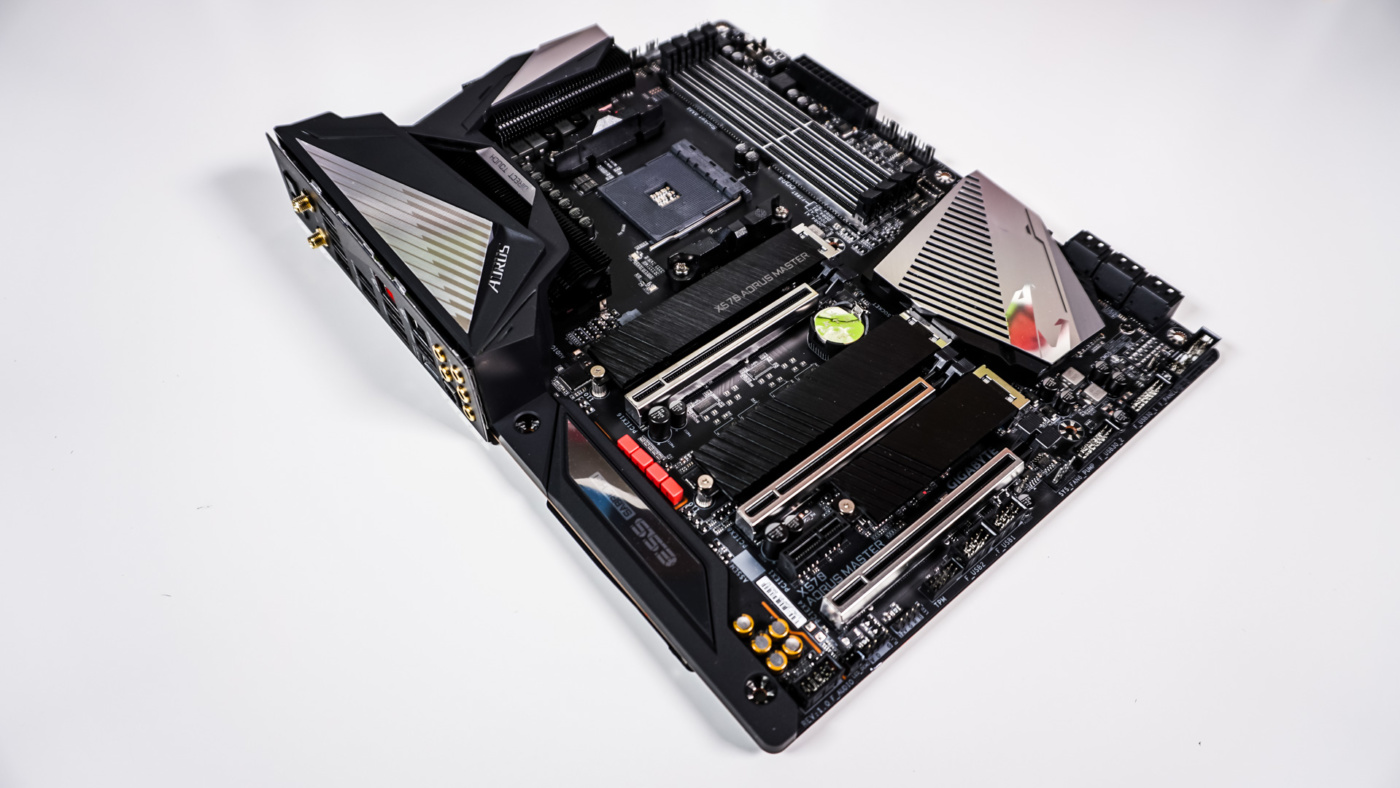Gigabyte X570 AORUS Motherboard Overview
The Gigabyte X570 AORUS Master motherboard keeps the same overall design that we saw on the Z390 AORUS Ultra board, so you have a black PCB with black and silver accents. Gigabyte has gone ahead and changed the color of the M.2 heatsinks from silver to black though, which I think was a good move.
Starting at the CPU socket we of course have AMD’s AM4 socket. X570 motherboards are compatible with 2nd generation and 3rd generation X570 motherboards. Gigabyte is making use of a direct 14 (12+2) phase Infineon digital power design. So you have the latest generation Infineon multiphase PWM controller and IR 3556 PowIRstage MOSFETs, which are capable of providing at least 50A of power from each phase, for a total of 700A. Gigabyte has redesigned their VRM heatsinks to a fine design. More fins mean more surface area, which results in better cooler. The VRM heatsinks are connected by a direct-touch heatpipe as well.


At the top corner of the board you’ll find two 8-pin EPS connectors. Only one is required for operation, but having two provides more stable power during overclocking. These connectors have metal shielding around them. Right next to them is a 4-pin fan header.
Moving over to the memory slots there are four metal-reinforced DDR4 DIMM slots. This board supports up to DDR-4400 (O.C.) memory on 3rd generation Ryzen processors. Above the memory slots is your CPU fan header and CPU optional fan header, a voltage checkpoint, a small microphone for noise detection (we’ll get into that in a little bit), a standard 4-pin RGB header, and a 3-pin addressable RGB header. Along the edge of the board is a large power button, smaller reset button, two dip-switches, your 24-pin ATX power connection, 3 more 4-pin fan headers, and a USB 3.1 gen 2 internal header. The top dip-switch enables or disables single BIOS mode. The bottom dip-switch allows you to toggle between the two different BIOS’s.


Coming down the board we have a Thunderbolt header and six SATA 6GB/s ports, which are set at a 90-degree angle. Right next to these is the chipset heatsink and active cooling fan, which has the AORUS logo on it. Active cooling fans are something you are going to see on almost every X570 motherboard. The X570 chipset actually uses 3 times as much power as the X470 chipset.


At the bottom of the board is where you’ll find the rest of your headers and connections. From left to right you have your HD audio headers, 3-pin addressable RGB header, 4-pin standard RGB header, TPM header, two USB 2.0 headers, a 4-pin fan header, two USB 3.1 gen 1 headers, and your front panel headers.
On the far edge of the board we have our audio components, which are mostly covered. Gigabyte is using the Realtek ALC1220-VB paired with the ESS SABRE reference DAC ES9118. The WIMA (red) and Nichicon audio capacitors are visible.
As far as expansion slots go you have three PCI-Express 4.0 x16 slots and a single x1 slot. Now these slots will only work in PCI-Express 4.0 mode if you have a 3rd generation Ryzen processor installed, if you install a 2nd generation Ryzen processor they will run at PCI-Express 3.0. With a single card installed it will always run at x16 speeds, but if you install two cards they will both run at x8 speeds. All three slots feature Gigabyte’s Ultra Durable PCIe armor.


The board also features four PCI-Express 4.0 M.2 slots, all of which have heatsinks on them. Two of them are M.2 2210 slots supporting M.2 SSDs up to 110 mm, while the third is an M.2 2280 supporting 80 mm M.2 SSDs. Remember these will only operate at PCI-Express 4.0 speeds if you have a 3rd generation Ryzen processor installed.
Coming up to the rear I/O it has a nice cover on it, that is sort of attached to the VRM heatsinks. It makes the top corner of the board look like a single piece, which I like. The rear I/O has an integrated shield as well, which is nice to see. Looking at the rear I/O from left to right you have Q-Flash Plus and Clear CMOS buttons, WiFi antenna connectors, four USB 2.0 ports, two USB 3.0 ports, four USB 3.1 gen 2 ports (3x type-A, 1x type-C), 2.5 GbE LAN, 1 GbE LAN, and your audio connections, which are gold plated. The WiFi on the board is the Intel WiFi 6 802.11ax + Bluetooth 5. The 2.5 GbE LAN is powered by a Realtek controller. Q-Flash plus allows you to update your BIOS via flash drive without even having a CPU, GPU, or memory installed. Q-Flash Plus is standard on all Gigabyte X570 motherboards.


Flipping the board over you are greeted by a large metal back-plate. This not only gives the board more stability, but also acts as a heatsink to keep components of the board cool.










